
Street Fighter 6 World Tour Mode review: how does it stack up as an RPG?
I know what you’re thinking.
“Why does RPG Site have a review for Street Fighter 6?” And the answer is, well - we don’t. We do have a review of a single mode of the game, though - because SF6’s ‘World Tour’ story mode is a fully-fledged RPG - and worthy of your attention.
A few weeks ago, Alex threw up the role-playing Batsignal after playing World Tour at a preview event. Now I’m here to follow it up with an unscored review (it wouldn’t be fair to score only one third of a broader package) based on over 20 hours tooling around in Street Fighter’s new open-world, RPG-laced experience. The truth is, it’s a pretty competent RPG that I enjoyed quite a bit.
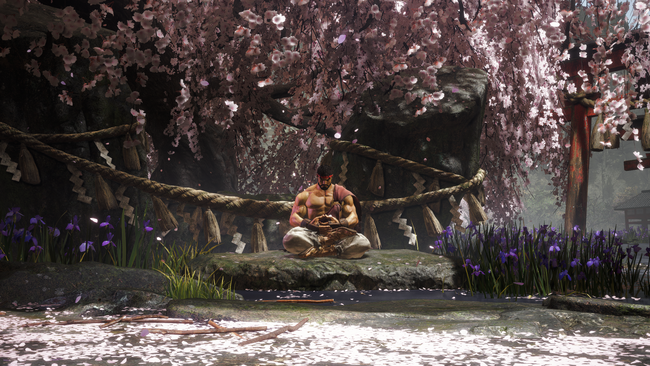
Back in the 90’s, fighting game single-player modes were typically just an Arcade Mode or a “Story” Mode that basically repackaged the Arcade Mode with a few dialogue exchanges before and/or after key fights. Obviously, the value of fighting games in this era was that these were often arcade ports brought to a home console, so people no longer had to feed coins into a machine continuously in order to keep playing.
In 2023, however, that no longer cuts it. There’s been a single-player content arms race - and every now and then, fighters have dipped a toe into the world of RPGs. Arc System Works included visual novel and RPG elements in BlazBlue, and Granblue Fantasy: Versus included full-blown RPG growth mechanics, which I wrote about at the time. And now, Capcom enters the ring with World Tour - its most extensive single-player offering in Street Fighter to date, and absolutely an RPG.
In fact, SF6 World Tour might be one of the biggest single-player offerings in any fighting game to date. The Street Fighter universe has been transformed to host a full-fledged explorable RPG - and it’s not bad either. Capcom has flirted with blending RPG systems into a fighting game before through Red Earth, but of course it was nowhere near Street Fighter 6’s level.

Street Fighter 6 is first and foremost a fighting game that will primarily appeal to fighting game fans. But I also think it’s a worthwhile game for those solely interested in RPGs.
There’s a peculiar novelty to fitting the framework of Street Fighter 6’s gameplay into RPG systems. This is a more earnest and admirable approach to a fighting game single-player mode, and addresses an issue that’s bugged me in other games by offering up a single-player mode that feels like more than a glorified tutorial designed to ease people into the ‘core’ fighting game package. World Tour accomplishes that too, but there’s a commitment and passion in its presentation and design that makes it feel like more than an afterthought.
Is it perfect? Certainly not. I’ll delve into the reasons in a bit, yet I just want to make it clear that this World Tour single player mode in Street Fighter 6 feels like something that was meaningfully crafted to be not just another reskinned, dumbed-down tutorial mode. It has its own unique mechanics and an angle that feels novel enough to RPG players that don’t normally dabble in fighting games.
What RPG fans should expect from SF6 World Tour
As you may have seen in the demo, or from the marketing, or all the monstrosities made on social media, Street Fighter 6 has a fairly robust character creator. The World Tour’s story follows the journey of an original character you make from scratch.
This actually has intriguing gameplay repercussions, because how you build your character defines some important aspects to consider in a fighting game. Short arms? Don’t expect your punches to connect consistently unless you’re right next to your foe all the time. Create a giant? Some of your attacks may not connect against smaller enemies. Fat body with thin legs? The upper half of your character is more vulnerable to longer reaching attacks since they’ll have wider hitboxes, while the opposition has to get close when opting for low attacks.
Experimentation is encouraged, as you can tweak, alter, and recreate your entire character’s model at any time for a small amount of in-game currency.
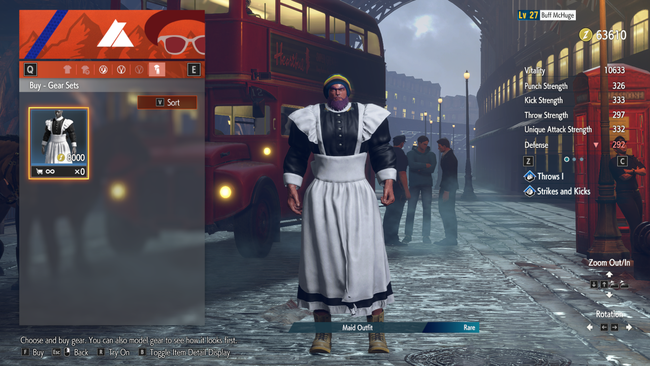
The main plotline in World Tour isn’t anything to write home about. Your created character is introduced to a rival early on, and most of the narrative consists of you uncovering the shady stuff that the Gary to your Ash is tangled up in. Of course, your character gets wrapped up in several incidents along the way including fighting in a few tournaments, investigating gang activity, and platforming their way into a shady organization through a construction site. Y’know, normal RPG stuff.
My main fascination throughout World Tour came from how Capcom turned a fighting game into an action RPG on a fundamental level. This has all the works that you would expect from a modern RPG - damage numbers, leveling up, stats, skill trees, side quests, consumable items, equipment, and so on.
Street Fighter 6’s World Tour initially revolves around Metro City, a recurring location in the multi-franchise universe that encompasses Street Fighter, Final Fight, and others. We’ve seen many glimpses of the city in other games - but not on this scale. Now, it is a fully explorable space in Street Fighter 6 and it’s quite large.
One of the first bizarre things about this lovely city is that you can just go up to most NPCs and challenge them to a fight or simply hit them to immediately initiate one. You see a named NPC taking out their selfie stick and it’s bugging you? Uppercut them and beat the ever living crap out of them.
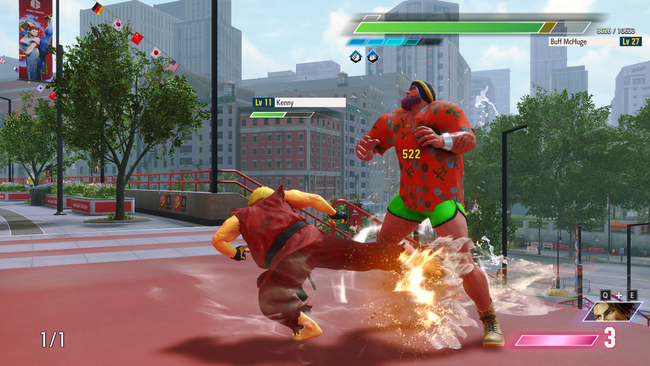
That cuts both ways, so some hostile NPCs will chase after you to get a swing in, dragging you into a fight you may not have been asking for. Some of the early game sections were surprisingly brutal in how often it would repopulate hostile NPCs right after you exit a fight, so the encounter rate may catch you off guard. Thankfully, going in and out of fights was practically seamless for me on PC. I can’t speak on how other platforms handle it, but loading into and out of encounters was practically instantaneous for me.
When combat begins, the game transitions to a classic Street Fighter 2D battle - though throwing hands with grunts feels more akin to a beat’em up brawler than a traditional fighter. Enemy health bars are displayed right above their models instead of the upper right corner because you’re usually facing off against multiple common enemies simultaneously. Some random battles have up to 8 enemies ready to pounce on you, though your character is only fighting 2 to 3 of them on-screen at any given time while they continually hop in off-screen as you take them out one-by-one.
These battles can be a bit unwieldy to navigate when enemies surround you from both sides. The game automatically handles side-swapping, so there’ll be times when I’m chasing down a specific opponent only for my character to be facing the opposite way to face someone else, which obviously messes with the direction of my attacks. It can get irritating against some of the more annoying enemy types later into World Tour.
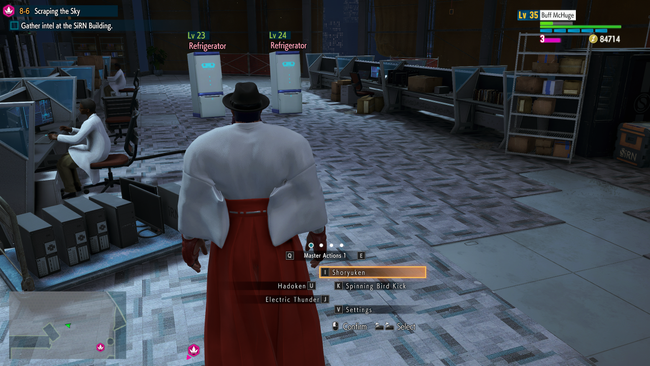
Some of the more endearingly goofy aspects in World Tour manifest in its enemy variety. There’ll be a lot of people you fight along the way - some use the movesets of Street Fighter 6’s base roster and others fire off unique attacks that are only found in World Tour. Don’t expect humans to be your only opposition either; sentient machinery including flying drones, roombas, refrigerators, and even server racks are down to tussle as well. It’s stupid, but it’s funny and pushes people to employ different tactics against them.
Key fights do employ the traditional round-based model. Just like other fights in World Tour, damage numbers and HP values are displayed in real-time with each hit. You can pause at any time to check sub-objectives that can reward items, money, or equipment, and you can use items in your inventory to heal or buff mid-fight.
Level disparity does make a huge difference in World Tour; if you’re up against someone that is way higher level than you, then expect to work a bit harder to earn your win because your hits will be slowly chipping away their health while a single combo from them may take away half of your lifebar instantly.
One touch I really appreciated is that the background scenery in fights actually reflects the nearby surrounding environment they’re engaged in. When fighting in Chinatown, there isn’t a “default” Chinatown stage that it falls back on; it takes into account which specific part of Chinatown you’re in. There was a battle I initiated that had an unopened treasure chest I missed in the background at one point. It is such a subtle, cool way to feel like you're always fighting in a different place.
This feels especially impactful because of the care put into designing Metro City itself. Longtime fans of Street Fighter and Final Fight are in for a treat because the art team went all-out in honoring the legacy of these legendary franchises, as well as other past Capcom fighting games. I adore all the little touches that celebrate that history. Numerous glowing neon signs jubilantly highlight characters while also serving as in-world advertisements, myriads of small fliers posted subtly wink at those familiar with Street Fighter’s lore, and there’s even some lesser-known niche characters from both series who have a role to play in the story and side quests.
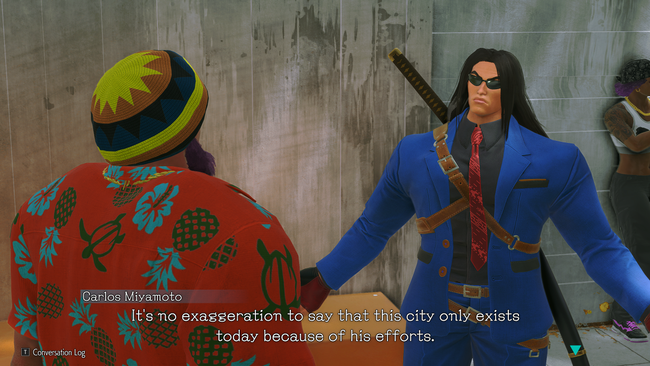
As you progress through the main story of World Tour, several side quests and activities are unlocked along the way. Most of these aren’t quite noteworthy, though the occasional cameo made me smile. A few recurring side quest chains serve as light tutorials, such as executing 3 anti-air attacks against a jumping opponent, defeating them with a Super Art, or firing off a specific amount of powered-up ‘Overdrive’ attacks.
My bigger issue with side quests are where some of these quest NPCs are placed around Metro City. While there are fast travel points that you manually activate to make moving around quicker, most of them are locked behind even more side quests. Even if you’re diligent about unlocking more fast travel spots, some parts of Metro City are just a pain to get to.
A certain elevated walkway strip early on will have you running back and forth to it frequently to meet with NPCs, but some of its points of entry are, frankly, kind of dogshit. For example, one is through a ladder in a back alleyway filled with hostile NPCs that will continually run after you in a cramped space until you’re overleveled enough that they back off, while the others are at the far ends of the map. It makes me wish that my character could just… ascend upwards through its floor to immediately get up there like a certain other game.
As the game expands beyond Metro City into a second similar large-scale open world zone later in the story, the same navigational woes continue.
Meanwhile, the handful of side activity minigames offered in World Tour are neat. There’s a blend between those that help practice execution and fundamentals, plus fun callbacks to previous games. One will have you attend to pizza orders by inputting motion commands as fast and as accurately as possible. The memorable Street Fighter II bonus stage that had players beat up a car with their bare hands is recreated in World Tour, though this time they’ll be up against a forklift instead.
My favorite one of these small pastimes is a clever minigame that basically teaches how to perform charge attacks. You’ll be tasked with cleanly slicing through glass bottles horizontally with karate chops. To store up the power needed to do so, you’ll have to hold a direction and a meter at the bottom will visually fill up to show how long you need to hold that direction before it is ready to be flung the other way along with pressing another button simultaneously to fire off a charge attack. I think it’s a smart, intuitive, and natural way to communicate how charge attacks are done to players who may be unfamiliar with the concept.

Continuous self-improvement is ultimately at the heart of Street Fighter 6’s World Tour mode. If there’s one thing it does supremely well, it is giving you the tools to make it feel like you’re continually creating and improving your own custom character with not only how they look, but how they play over time.
Your character meets the playable roster of Street Fighter 6 throughout World Tour. These famous characters serve as ‘masters’, mentors that teach you their fighting style and special moves. Unfortunately, almost all of them don’t really amount to much more than that which is a bummer; I would’ve liked to see at least a few more of them be somewhat involved in the main storyline. The cutscenes that introduce them and when your character enrolls under them were all especially amusing.
If you’re planning to strictly mainline World Tour’s critical path, you won’t meet a good number of them because several are locked behind side quests. Some of them are also in other parts of the world, so you’ll have to fly outside of Metro City to meet them. These locales aren’t sprawling open-world zones, but are basically just small rooms that contain the famous face, a merchant with local wares, and a few other NPCs. There’s only one other area that’s as big as Metro City, while the other dozen locations you can visit are merely tiny spaces to interact with these one-off characters in World Tour.

Street Fighter 6’s main cast also bequeaths ‘Master Actions’, moves that can be performed outside of combat. Since your character can’t jump, some of these can be used to navigate the open world environments. Dhalsim’s teleport or Chun-Li’s spinning kick can cross over gaps. Ryu’s or Luke’s uppercuts raise you high enough to function as a jump to higher platforms. Master Actions serve as a way to preemptively hit someone to start a fight too.
When your character learns someone’s style for the first time, they can “equip” it and adopt that character’s posture, walk speed, dash, normal attacks, and character-specific mechanics when they’re “wearing” it. If a character equips Ken’s style, they’ll emulate the way he moves in battle and have access to his punches, kicks, target combos, and his exclusive forward dash that ends in different attacks depending on which kick button is pressed during it. Now if that same character switched to Chun-Li’s style, they would be able to perform her normal attacks, her wall jump ability, and switch to her other additional stance.
Meanwhile, your character’s arsenal of special moves is up to you. Would you like to have Guile’s playstyle but fire off Ryu’s Hadoken and Shoryuken instead? Go for it. Do you like how agile Cammy is, but wish you had Zangief’s command grab and Blanka’s thunder move too? You’re more than welcome to do so, as long as you’ve met these characters before and got their style.
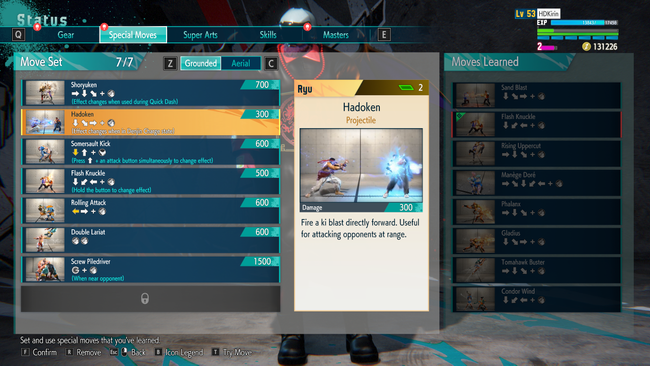
Although you won’t get all of a character’s special moves at first, you’ll unlock the rest after their style rank reaches a certain level. Style experience points are segregated among every single character’s style, but you can receive experience for other styles you don’t have equipped by beating up people who do use that character’s style in battle. If you’re adamant about sticking with a specific style, you do unlock the ability to eventually feed experience points to other characters’ styles once you reach a style’s maximum rank.
Leveling up style ranks is a worthwhile endeavor for Street Fighter series enthusiasts, since new interactions open up that lead to unique artwork and illustrations as the roster shares what they’ve been through and what’s been going on with them. If you’re eager to see which series characters have intertwined with them, vigilantly leveling up multiple styles may be a worthwhile effort to you.

The only limitation on which special moves a character can equip is that you can’t have two moves that have the same input command for obvious reasons. There’s also initially a restricted number of special moves you’re able to equip at first, though this resolves itself as you unlock more slots through World Tour’s skill tree. Beyond that, you’re free to experiment - and create something gloriously personalized and broken.
As your character levels up, they’ll obtain skill points to feed into the skill tree. World Tour handles this in a pretty interesting way on a conceptual level. These aesthetically look like a tournament bracket, so you’re navigating your way upwards to “complete” a skill tree before moving to a new skill tree to navigate through.
At the bottom of each skill tree, you’ll have an even number of selections - let’s say there’s an initial pool of eight skills that you can choose from. These skills are divided into four pairs and you can only choose a single one from each pair to learn. If the first two skills are stat increases to either your punches or kicks, then once you make a selection, the other one cannot be learned. So if you choose to increase the damage of your punches here, then you cannot select the one that raises the damage of your kicks.
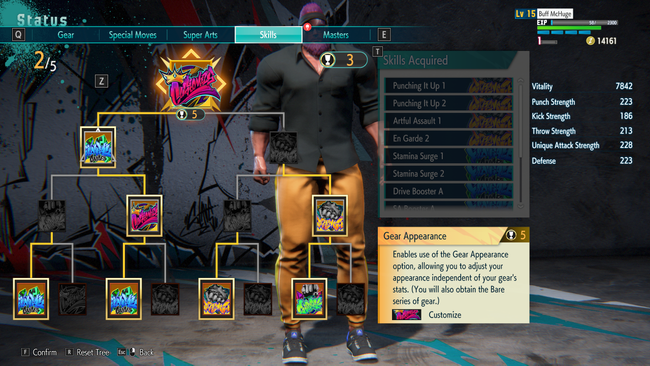
You’ll make similar selections for the rest of the three pairs before advancing to the next tier which now only has a pool of four skills; these are, once again, divided into pairs and you’ll continue to navigate this skill tree until the single top one is learned. Then, it’ll move on over to the next skill tree and you start at the bottom once more.
It’s a neat approach given the context of being a fighting game turned RPG, yet the actual skills you learn aren’t all that exciting. Most of them are stat increases to your HP, defense, punches, kicks, throws, and special moves along with the occasional selection to equip more special moves or getting a bigger discount at equipment shops. The most significant stuff out of the skill trees I’ve gone through have been unlocking the ability to slow down time in order to navigate more easily around hostile NPCs, and the ability to transmogrify my gear, so you can equip a set that gives the highest numbers without sacrificing your sense of fashion to do it.
The clothing is particularly impressive when you take into account the wild models and proportions you can make in the character creator. They also have to be properly fitted as your character cycles through multiple character styles that have their body move in all sorts of different ways. This is especially true for a character like Dhalsim, whose entire moveset revolves around stretching his limbs for extremely far reaching attacks - and the clothing does stretch out with it, amazingly enough.
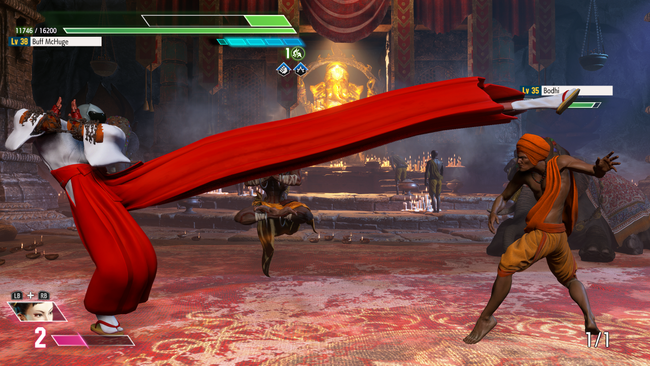
Hopefully this has painted a better picture of what you can expect out of this World Tour RPG mode now. It’s fairly comprehensive for a single player offering in a fighting game that isn’t quite the focus of the overall package, yet it’s expansive enough to stand on its own.
So, is it recommended for RPG fans?
Street Fighter 6’s World Tour is ultimately one of my favorite single-player experiences in the fighting game genre. While that’s admittedly quite a low bar to clear, I was genuinely impressed by it. The crossover of fighting game mechanics and RPG progression systems and world interactions should be unique and interesting enough that it’s a worthwhile experience for RPG enthusiasts looking for something different.
The entire World Tour mode is merely one-third of the overall Street Fighter 6 package - but there’s still a lot to it. The main journey and a good handful of side quests should last for over 20 hours, with grind-heavy post-game challenges available after the credits roll. Custom characters can be taken online to face-off against other people’s customs also, allowing you to show off your build, gear, and setup - and witness the ridiculous creations others have made.
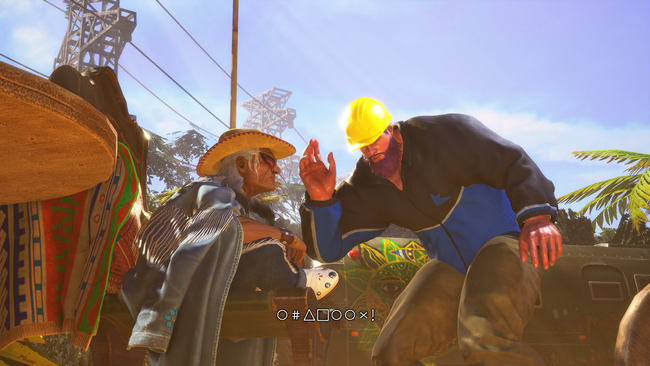
There’s admittedly significant flaws with some frustrating quest NPC placements, unintuitive world structure, and a bland main storyline. Fighting can feel repetitive if you aren’t really switching up character styles or experimenting with different movesets and special moves. Some of the menuing can feel tedious because switching to a new style for the first time resets all your special moves, so you’ll have to rebind them for that new style before the game remembers them. The early hours are a bit of drag too.
This is by no means a stellar RPG that will join the classics any time soon, but that’s okay because I appreciated the effort made from the development team to have something this expansive and robust in a fighting game. I hope other fighting games in the future take some aspects of Street Fighter 6’s World Tour and make it into their own thing. I’d love to see what others could achieve if they took a similar approach.
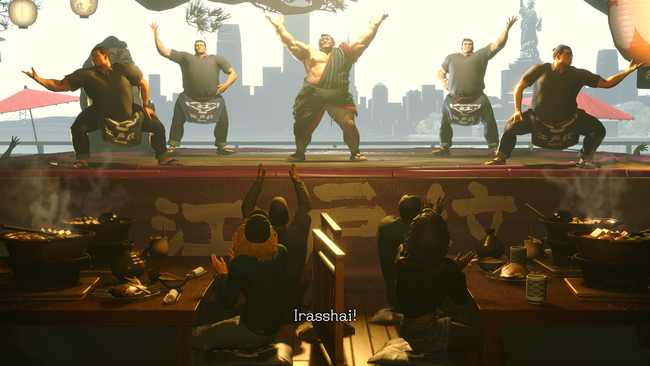
If you’re not a fighting game fan, I’m not here definitively saying that Street Fighter 6 is worth your investment at full price. World Tour is good, but it’s not really a full game unto itself. RPG fans shouldn’t write this off as a simple fighting game either. So much love and care has been put into its combination of fighting, role-playing, and fanservice - and you can feel that whether you’re a fan or not. That’s important.